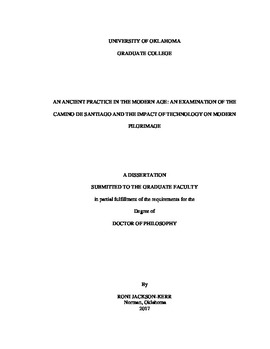| dc.description.abstract | For more than twelve hundred years, sojourners have been walking the pilgrim routes of El Camino de Santiago de Compostela, also known as The Way of Saint James, in northern Spain. With a long and varied history, the Camino de Santiago is a fascinating phenomenon. In modern decades, pilgrimage has become a popular area of study, and the Camino is no exception. Nancy Frey’s famous text, Pilgrim Stories, stands among the seminal anthropological works on the topic. However, much has changed in the two decades since Frey’s work was originally published. The most notable change relates to technological advancement. From online forums to wi-fi access in albergues [pilgrim hostels], the modern Camino varies greatly from even its modern historic iterations.
The impact of such rapid technological advancement can scarcely be overstated. This dissertation seeks to explore the far-reaching impact of technology on the ancient pilgrimage, and the perceptions of pilgrims of the impact of technology along The Way. The Internet has changed everything for those who live within its far-reaching grasp, and the Camino is no exception. From the manner in which pilgrims gather information before embarking on their journey to the ways in which pilgrims stay in touch after returning home and every step in between, technological advancements have impacted the entire experience from start to finish. On the road, technology pervades the experience. While the Camino was once seen as an escape from modernism and a return to ancient ways of being, online pilgrim forums today are flooded with questions regarding the best “apps” [mobile applications] to download before starting the Camino, how to charge Smartphones and tablets while on the road, and what methods are available for electronically mapping the route. Pilgrims are documenting their journeys online through online blogs and social networking sites such as Facebook and Instagram. They are maintaining close contact with friends and loved ones while on the road with the aid of communication technology, and wi-fi can be found in most modern albergues and in cafes along the trail.
This work seeks to understand the inevitable tensions and varying perspectives regarding the Camino in the modern age, the ways in which technology is affecting pilgrim interactions, as well as the reflective nature of pilgrimage in the age of personal broadcasting. Most importantly, this work will seek to explore the discursive and experiential elements of the Camino and the implications of modern technology on both discourse on pilgrimage and the experience of pilgrimage itself. | en_US |
